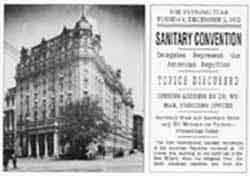
At the turn of the century representatives from 11 countries in the Americas met to organize a united front against the spread of pestilence and disease that engulfed the region at that time. This gave birth to what was to become the oldest, continuously functioning international health agency in the world, The Pan American Sanitary Bureau (PASB) with Dr. Walter Wyman as the first Chairman.
Meetings were held every two years from 1905 through 1911 throughout the Americas with the focus on not only quarantine issues, but promotion of health as a whole, including smallpox vaccine, malaria and tuberculosis campaigns, national health legislation, scientific study of tropical diseases, with emphasis on parasitology and pathologic anatomy, laboratory research into tropical medicine and general pathology.
After World War I the stage was set
for a new era of cooperative progress in health in the Americas. Scientific
knowledge about the cause and spread of many infectious diseases had advanced
enough to begin to control them, and governments were aware of the urgency
of setting up services to protect the public health.